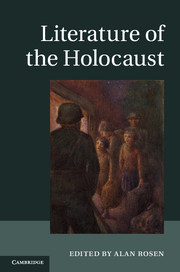Book contents
- Frontmatter
- Contents
- Notes on contributors
- Acknowledgments
- Introduction
- Part I Wartime victim writing
- Part II Postwar responses
- Part III Other approaches
- Chapter 12 Oral memoir and the Shoah
- Chapter 13 Songs of the Holocaust
- Chapter 14 Sephardic literary responses to the Holocaust
- Chapter 15 Anthologizing the Holocaust
- Chapter 16 The historian’s anvil, the novelist’s crucible
- Guide to further reading
- Index
- References
Chapter 13 - Songs of the Holocaust
Published online by Cambridge University Press: 05 June 2014
- Frontmatter
- Contents
- Notes on contributors
- Acknowledgments
- Introduction
- Part I Wartime victim writing
- Part II Postwar responses
- Part III Other approaches
- Chapter 12 Oral memoir and the Shoah
- Chapter 13 Songs of the Holocaust
- Chapter 14 Sephardic literary responses to the Holocaust
- Chapter 15 Anthologizing the Holocaust
- Chapter 16 The historian’s anvil, the novelist’s crucible
- Guide to further reading
- Index
- References
Summary
The songs that were created by Nazism’s victims are some of the most valuable contemporary oral and written texts to have been produced during the Holocaust. Numbering in the thousands, they chronicle the experiences and responses of diverse individuals and groups across the European continent. Jews, political prisoners, Roma and Sinti, Soviet prisoners of war, Jehovah’s Witnesses, and countless others used song as a means through which to document, interpret, and respond to what was happening to them, from the earliest concentration camps established in 1933 through to the liberation in 1945 and beyond.
As a major body of texts originating from the time, songs stand alongside the diaries, ghetto chronicles, poems, and other literary creations that were preserved. In this sense, they belong firmly within the canon of Holocaust literature, although their close relationship with non-musical texts is often overlooked. The reason for this is probably that songs, unlike other literary forms, were seldom published or even written down at the time. For the most part, they were preserved as oral texts, not only by their creators but more frequently by others who heard and remembered them; indeed, in many cases we do not know who originally wrote them. Rather than being buried in the ground or safely hidden away, they were preserved precisely because they were sung: in other words, their survival depended on active oral transmission among individuals and groups. This fact in turn allows us cautiously to infer that the songs that survived did so because they resonated in some way with those who sang them. In a world where newspapers, radios, and other forms of communication had almost or entirely ceased functioning, songs became an informal space where information and experiences could be shared. They acknowledged wishes, fears, and uncertainties in the public realm; as they circulated, people identified with them, modified them, rejected them, or perhaps did not engage with them at all. The access they offer is of course not direct or uncomplicated: the process through which songs were created and circulated was informal and unregulated, and it would be impossible to extract from them a representative collective narrative. Nonetheless, they offer significant insight into the ideas and perspectives with which victims identified, and the concerns that preoccupied them.
- Type
- Chapter
- Information
- Literature of the Holocaust , pp. 211 - 224Publisher: Cambridge University PressPrint publication year: 2013



